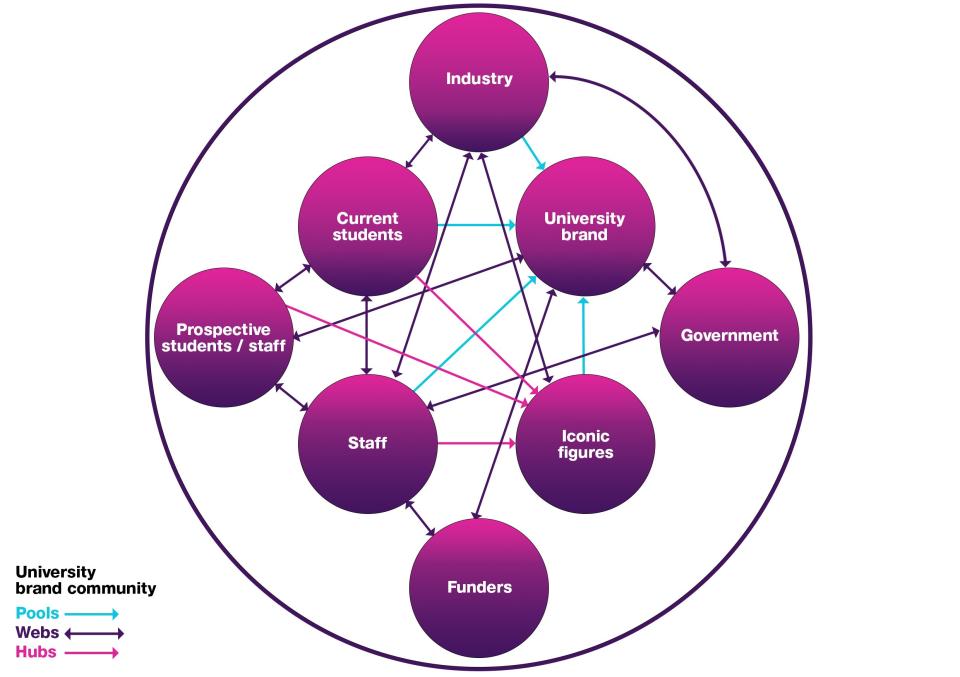
University brand communities: building reputation among different audiences
As the interface between organisations and their key stakeholders, brands are dynamic assets. They morph, develop and adapt over time to continuously create identification, differentiation and value for their audiences and wider society. Brands live in the minds of their audiences and have value. What audiences think and feel, their perceptions and expectations, is at the heart of what brands are. It is what makes them distinctive and relevant.
Universities recognise the importance of developing strong brands to articulate their essence and quality. University brands involve the co-creation of meaning between institutions and their internal audiences (students, staff and alumni) and external audiences (prospective students and staff, industry, government and funders). Fostering a brand community is important for bringing all these audiences together.
- Sea of sameness: why universities have trouble with branding
- How to achieve PR impact with little – or no – budget
- Amplify the authentic student voice in university marketing
What is a brand community?
A brand community is based on social relationships among brand enthusiasts. They identify with and commit to the brand community, explaining their loyalty to it to others and promoting its quality. For example, influencer marketing continues to be a strong trend for universities. In decision-maker surveys, we consistently see YouTube cited as a main source of information for prospective students. User-generated video content attracts high engagement on social media channels. At open-day events, we are told that talking to staff, current students and alumni helps prospective students and families to engage with our community of brand enthusiasts.
Institutions can foster the creation of a university brand community by combining three types of community affiliation: pools, webs and hubs.
Pools
A set of people who have a strong connection, with shared goals and values, yet loose associations with each other, form a pool.
A university brand constitutes a set of shared goals and values, often articulated in the mission and vision statement, with “admirers” who hold strong connections to these values. This links to reputation, where universities might be viewed differently according to the stakeholder. For example, one university might have a strong reputation among its employees, an ambivalent reputation with its students and a weak reputation with government. This is why a strong pool is important and can be fostered using multi-pronged communication channels. Internally, this can include newsletters, face-to-face discussions and intranet sites. Externally, this can be through direct engagement with relevant media as well as through events, partnerships and brand campaigns. However, many universities are doing this already and therefore find it difficult to create stand-out brand propositions for campaigns, as parodied by social media accounts such as Bantshire University. Something that has helped us at the University of Bristol is to work with student content creators to co-create videos based on their perspectives of the university rather than something we think or assume our audiences will enjoy. In other words, work with your key stakeholders to co-create something distinctive rather than doing it all yourselves.
Webs
Although it is important to identify and consistently communicate a set of values that bind audiences with a brand in an emotional way, it is not sufficient to guarantee those audiences will develop interpersonal relationships with each other. Yet relationships are the very essence of a brand community and the reason institutions must foster the development of webs, which are social networks bound by one-to-one associations in the form of inter-audience (staff–students) and intra-audience (student–student or staff–staff) relationships.
Webs have become particularly salient in the aftermath of the pandemic, with organisations exploring different ways of forging strong relationships while promoting flexible work patterns. Universities can build bonds between students and staff by holding joint committees that influence decision-making, hosting staff and student events, and connecting through personal tutoring.
Staff can connect with each other through “heads-up” days on campus with time to meet, discuss, problem-solve and socialise in person, in contrast with “heads-down” days concentrated on writing papers and marking assignments that can be easily achieved remotely.
Student-to-student relationships are facilitated through WhatsApp and Facebook groups as well as clubs, societies and initiatives such as the Global Lounge, which provides a space for celebrating international events and language cafés. This all helps to build social bonds.
Hubs
Finally, hubs are sets of people brought together thanks to their admiration for iconic figures (think Michael Jordan for Nike, Elon Musk for Tesla and the late Steve Jobs for Apple). In university branding, hubs can be scholarly communities brought together by their admiration for figurehead scholars, who when they join can bring new members into the university brand community. If they leave, however, they can take away their followings, so these “celebrities” require careful management.
The reputation field tells us that celebrity leaders can swing both ways: when things are going well, they can attract interest, investment and excitement, but when things are going badly they can create unwanted attention and negative noise, and make people think poorly about your brand. Having a strong spokesperson at the head of the university who engages with the press, the public and internal audiences helps bring prominence to the institutional brand. Alongside the valuable public role of our vice-chancellor, we work closely with academics, providing training to upskill them, enhancing their profiles through social media, blogging and media outlets. This network marketing approach helps to build our brand with academics and new audiences worldwide.
Pools, webs and hubs, as sets of community affiliation, should be combined in a mutually reinforcing system to create a brand community, as per Figure 1 below. Associations to shared goals and values, inter-audience and intra-audience relationships, and connections to central figures can only develop and evolve organically through the initiative of the audiences themselves. Thus, institutions cannot force university brand communities into being, but they can support their creation by pursuing the nexus of pools, webs and hubs.

Sotiris T. Lalaounis is senior lecturer in marketing and director of student experience; William S. Harvey is professor of leadership and education director, and author of Reputations at Stake; and Corinna Booth is marketing manager; all at the University of Bristol Business School.
If you found this interesting and want advice and insight from academics and university staff delivered direct to your inbox each week, sign up for the THE Campus newsletter.




